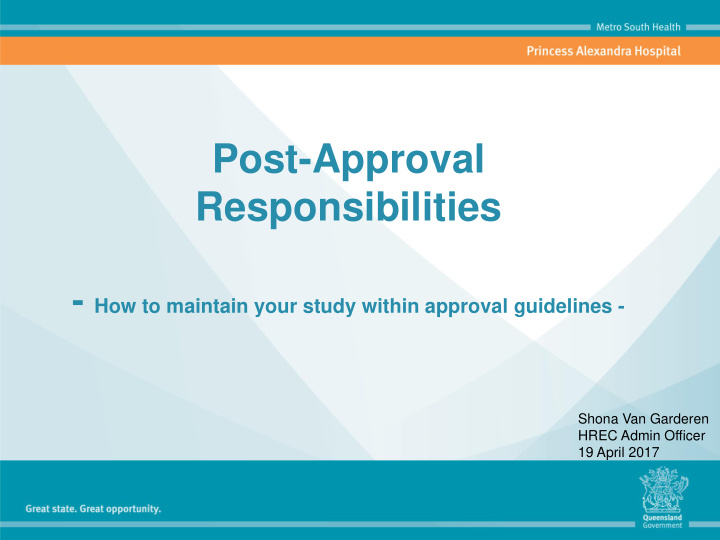



Post-Approval Responsibilities - How to maintain your study within approval guidelines - Shona Van Garderen HREC Admin Officer 19 April 2017
Study has been cleared by Ethics and given Governance Approval – yay!
So that’s it all done now, right? • In short – no. • Through out the life of the study, things may happen that necessitate changes to study documentation which may need to be approved by the Human Research Ethics Committee (HREC). • Additionally there are certain reporting requirements that must be met during the study period in order to ensure that Ethical Clearance and Governance Approval remain in place. – Notification of Commencement – Amendments – Annual Progress Reports – Safety Reporting – Finalisation/Closure of Study
Notification of Commencement • When the research team “pick up a pen” and begin the study, the date this occurs must be notified to the HREC and Research Governance (external studies only). • Complete the MSF11 Research Commencement Form and email through to the office. • Important aspect of compliance as it informs us that the research project has begun and moves the study into “active” on our system.
Amendments – When are they needed? • Change to Principal/Associate Investigators or Contact Person only; do not need to be informed of research assistants or other staff. • Addition/Removal of study sites • Extension of Ethical Clearance: standard initial approval is only for 3 years, so if a study needs to continue beyond this time frame, need to apply for an extension. Must include justification for more time and also be accompanied by annual report. • Updates to study documentation : Protocol, Investigator’s Brochure, Participant Information and Consent Form, Advertising etc. • HREC/Governance must always have the most up-to-date documents on file for a study for compliance purposes • Generally do not approve “sub - studies” through amendment process, particularly if addressing new research aims/outcomes • Amendments need to be within the risk level of the original approval eg if study was approved as Low Risk Research, then amendments should not raise the risk level. If this occurs, a new Standard Risk application may be needed.
Amendments - How to submit • Complete the MSF49 Metro South Amendment Form and email through to the office. • Need to include other relevant documentation such as: – Tracked and clean copies of updated documents – CVs for new investigators – Letter of acceptance of responsibility from lead investigators at new sites – Annual Report when applying for extensions
Annual Progress Reports • Must be submitted annually on the anniversary of HREC Ethical Clearance in order to maintain ongoing compliance. • Enables HREC to oversee the progress of the study such as recruitment numbers, any issues that have occurred in past twelve months etc. • Good opportunity to reflect on the state of your study and ensure that all documentation is up-to-date in case you are monitored. • Complete MSF17 Annual Progress Report and send via email to HREC Office .
Safety Reporting • In November 2016, NHMRC released an updated Guidance on Safety Reporting and Monitoring for clinical trials. • Metro South HREC has adopted this new guidance and the changes are as follows: – Adverse Events (AEs), Serious Adverse Events (SAEs), Suspected Unexpected Serious Adverse Reactions (SUSARs), Unanticipated Serious Adverse Device Effects (USADEs), and Six Monthly Line Listings no longer need to be reported to the HREC. These are only reported to the Sponsor. – Significant Safety Issue, which results in a change to the study protocol or consent forms, must be reported to the HREC within 15 days along with the updated documentation. – Urgent Safety Measure, which results in change in risk level of a participant, must be reported to the HREC within 72hrs with a plan on how to manage new risk level. – Annual Safety Report that includes clear summary of evolving safety profile of the trial and also evidence that sponsor is conducting its ongoing safety monitoring appropriately. Executive Summary of a Development Safety Update Report (DSUR) would be acceptable.
Safety Reporting Summary • Significant Safety Issue – • Adverse Events (AEs), • Serious Adverse Events (SAEs), 15 Days • Suspected Unexpected Serious • Urgent Safety Measure – Adverse Reactions (SUSARs), 72hrs • Unanticipated Serious Adverse Device • Annual Safety Report Effects (USADEs), • Six Monthly Line Listings
Study Finalisation and Closure • When all activity on a study has been completed, “pens are down”, that is when you submit a Final Research Report to the HREC. • Or if a study is terminated early, suspended ,or made in-active for some reason, also submit this form. • MSF18 Research Final Report Notification Form • Send to HREC Office via email. Must be signed and dated by Principal Investigator. • Ensures that only ‘active’ studies are kept open on our system and you won’t receive any Annual Progress Report reminders!
Thank you Any questions?
Recommend
More recommend